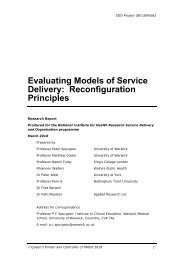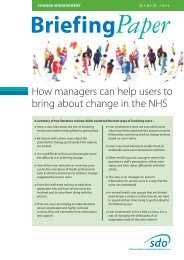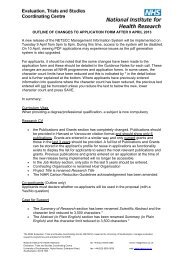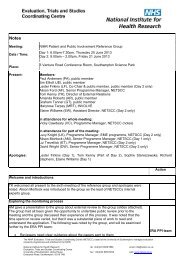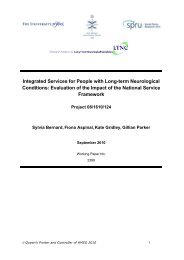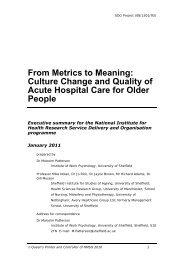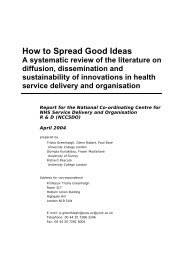Evaluation of IT modernisation in the NHS - NETSCC
Evaluation of IT modernisation in the NHS - NETSCC
Evaluation of IT modernisation in the NHS - NETSCC
You also want an ePaper? Increase the reach of your titles
YUMPU automatically turns print PDFs into web optimized ePapers that Google loves.
Report to SDO for NCRS ProjectIntroduction• Automated and secure audit trail for decisions, us<strong>in</strong>g electronicf<strong>in</strong>gerpr<strong>in</strong>ts/signatures.• More accurate, and more readily available, <strong>in</strong>formation for plann<strong>in</strong>g andperformance monitor<strong>in</strong>g purposes locally; more accurate data returns fornational purposes achieved more efficiently.Our orig<strong>in</strong>al aim was to evaluate <strong>the</strong> implementation <strong>of</strong> electronic patient records(EPRs) <strong>in</strong> four ma<strong>in</strong> areas: processes; consequences, both <strong>in</strong>tended andun<strong>in</strong>tended; <strong>the</strong> associated costs and sav<strong>in</strong>gs <strong>of</strong> <strong>the</strong> processes andconsequences; lessons for future implementation. We described two specificobjectives:(a) To evaluate <strong>the</strong> consequences and costs/sav<strong>in</strong>gs <strong>of</strong> implement<strong>in</strong>g EPRs <strong>in</strong> arange <strong>of</strong> secondary acute Trusts;(b) To evaluate <strong>the</strong> processes and impact <strong>of</strong> implement<strong>in</strong>g EPRs on <strong>the</strong>organisation, all levels <strong>of</strong> staff and patients.Information for Health required all acute Trusts to implement EPRs. 1At <strong>the</strong> time<strong>of</strong> f<strong>in</strong>alis<strong>in</strong>g <strong>the</strong> project <strong>in</strong> 2003, <strong>the</strong> target date for achiev<strong>in</strong>g full implementationwas rescheduled to December 2007, 2 with <strong>the</strong> Government acknowledg<strong>in</strong>g thatEPRs had “not yet been adopted on a national scale”. At <strong>the</strong> time, we saw a clearopportunity for <strong>the</strong> study to identify important lessons for implementation. EPRswere also be<strong>in</strong>g implemented <strong>in</strong> “different ways” across acute Trusts. SomeTrusts had <strong>the</strong> advantage <strong>of</strong> ‘new build’ projects, which allowed <strong>the</strong> ‘hardware’and ‘s<strong>of</strong>tware’ <strong>in</strong>frastructure for EPRs to be <strong>in</strong>stalled <strong>in</strong> an optimal fashion. O<strong>the</strong>rTrusts were establish<strong>in</strong>g EPR functionality by modify<strong>in</strong>g exist<strong>in</strong>g <strong>IT</strong> systems.1.2. Changes to <strong>the</strong> conception <strong>of</strong> <strong>the</strong> projectIn November 2003, <strong>the</strong> SDO agreed that changes to <strong>the</strong> project protocol wererequired. These changes were needed because <strong>the</strong> government’s orig<strong>in</strong>al planfor implement<strong>in</strong>g electronic patient records (EPRs) <strong>in</strong> <strong>the</strong> <strong>NHS</strong> (on which ourapplication and orig<strong>in</strong>al objectives were based) 1,2 had been abandoned dur<strong>in</strong>g <strong>the</strong>period between submission <strong>of</strong> <strong>the</strong> application and contract<strong>in</strong>g <strong>of</strong> <strong>the</strong> project.2




